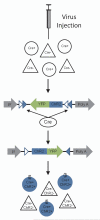Spotlight on movement disorders: What optogenetics has to offer
- PMID: 25777796
- PMCID: PMC4397176
- DOI: 10.1002/mds.26184
Spotlight on movement disorders: What optogenetics has to offer
Abstract
Elucidating the neuronal mechanisms underlying movement disorders is a major challenge because of the intricacy of the relevant neural circuits, which are characterized by diverse cell types and complex connectivity. A major limitation of traditional techniques, such as electrical stimulation or lesions, is that individual elements of a neural circuit cannot be selectively manipulated. Moreover, available treatments are largely based on trial and error rather than a detailed understanding of the circuit mechanisms. Gaps in our knowledge of the circuit mechanisms for movement disorders, as well as mechanisms underlying known treatments such as deep brain stimulation, make it difficult to design new and improved treatment options. In this perspective, we discuss how optogenetics, which allows researchers to use light to manipulate neuronal activity, can contribute to the understanding and treatment of movement disorders. We outline the advantages and limitations of optogenetics and discuss examples of studies that have used this tool to clarify the role of the basal ganglia circuitry in movement.
Keywords: Channelrhodopsin; DBS; Parkinson's disease; dystonia.
© 2015 International Parkinson and Movement Disorder Society.
Figures



Similar articles
-
Optogenetically-inspired neuromodulation: Translating basic discoveries into therapeutic strategies.Int Rev Neurobiol. 2021;159:187-219. doi: 10.1016/bs.irn.2021.06.002. Epub 2021 Jul 21. Int Rev Neurobiol. 2021. PMID: 34446246 Review.
-
Illuminating circuitry relevant to psychiatric disorders with optogenetics.Curr Opin Neurobiol. 2015 Feb;30:9-16. doi: 10.1016/j.conb.2014.08.004. Epub 2014 Sep 15. Curr Opin Neurobiol. 2015. PMID: 25215625 Free PMC article. Review.
-
Chapter 33: the history of movement disorders.Handb Clin Neurol. 2010;95:501-46. doi: 10.1016/S0072-9752(08)02133-7. Handb Clin Neurol. 2010. PMID: 19892136 Review.
-
Pharmacogenetic and optical dissection for mechanistic understanding of Parkinson's disease: potential utilities revealed through behavioural assessment.Neurosci Biobehav Rev. 2014 Nov;47:87-100. doi: 10.1016/j.neubiorev.2014.07.026. Epub 2014 Aug 7. Neurosci Biobehav Rev. 2014. PMID: 25109690 Review.
-
Optogenetics in Drosophila Neuroscience.Methods Mol Biol. 2016;1408:167-75. doi: 10.1007/978-1-4939-3512-3_11. Methods Mol Biol. 2016. PMID: 26965122
Cited by
-
Mediodorsal Thalamus Contributes to the Timing of Instrumental Actions.J Neurosci. 2020 Aug 12;40(33):6379-6388. doi: 10.1523/JNEUROSCI.0695-20.2020. Epub 2020 Jun 3. J Neurosci. 2020. PMID: 32493711 Free PMC article.
-
Viral vector-based tools advance knowledge of basal ganglia anatomy and physiology.J Neurophysiol. 2016 Apr;115(4):2124-46. doi: 10.1152/jn.01131.2015. Epub 2016 Feb 17. J Neurophysiol. 2016. PMID: 26888111 Free PMC article. Review.
-
Synaptic plasticity may underlie l-DOPA induced dyskinesia.Curr Opin Neurobiol. 2018 Feb;48:71-78. doi: 10.1016/j.conb.2017.10.021. Epub 2017 Nov 7. Curr Opin Neurobiol. 2018. PMID: 29125979 Free PMC article. Review.
-
New Targets and New Technologies in the Treatment of Parkinson's Disease: A Narrative Review.Int J Environ Res Public Health. 2022 Jul 20;19(14):8799. doi: 10.3390/ijerph19148799. Int J Environ Res Public Health. 2022. PMID: 35886651 Free PMC article. Review.
-
Light-induced regulation of ligand-gated channel activity.Br J Pharmacol. 2018 Jun;175(11):1892-1902. doi: 10.1111/bph.14022. Epub 2017 Oct 6. Br J Pharmacol. 2018. PMID: 28859250 Free PMC article. Review.
References
-
- Boyden ES, Zhang F, Bamberg E, Nagel G, Deisseroth K. Millisecond-timescale, genetically targeted optical control of neural activity. Nat Neurosci. 2005;8(9):1263–1268. - PubMed
-
- Miesenbock G, Kevrekidis IG. Optical imaging and control of genetically designated neurons in functioning circuits. Annu Rev Neurosci. 2005;28:533–563. - PubMed
-
- Oesterhelt D, Stoeckenius W. Rhodopsin-like protein from the purple membrane of Halobacterium halobium. Nat New Biol. 1971;233(39):149–152. - PubMed
Publication types
MeSH terms
Grants and funding
LinkOut - more resources
Full Text Sources
Other Literature Sources
Medical

